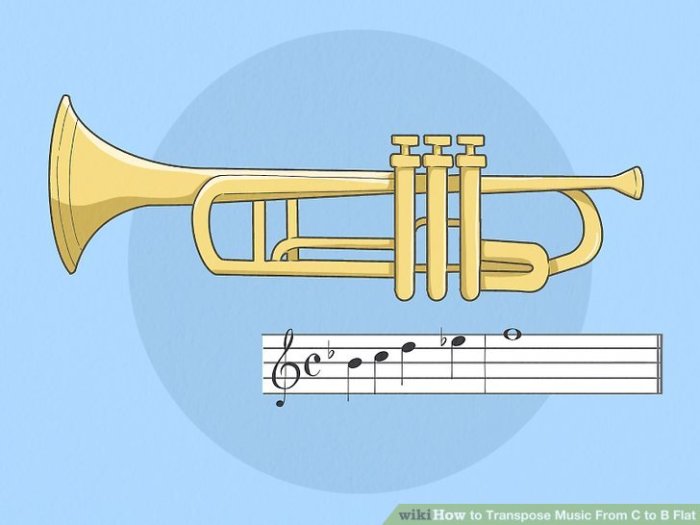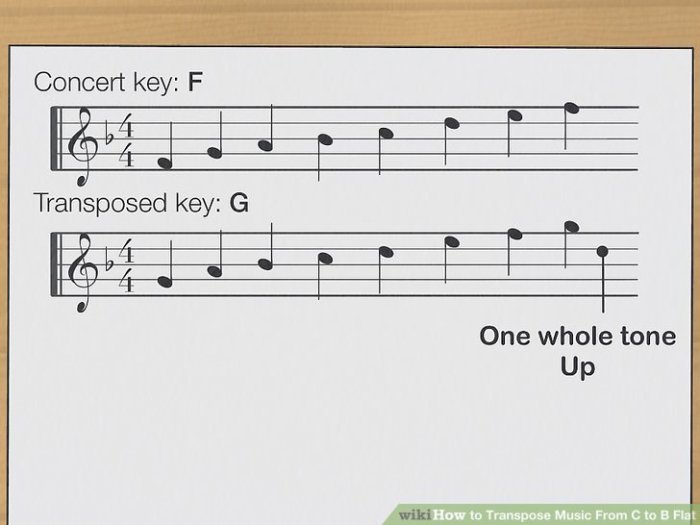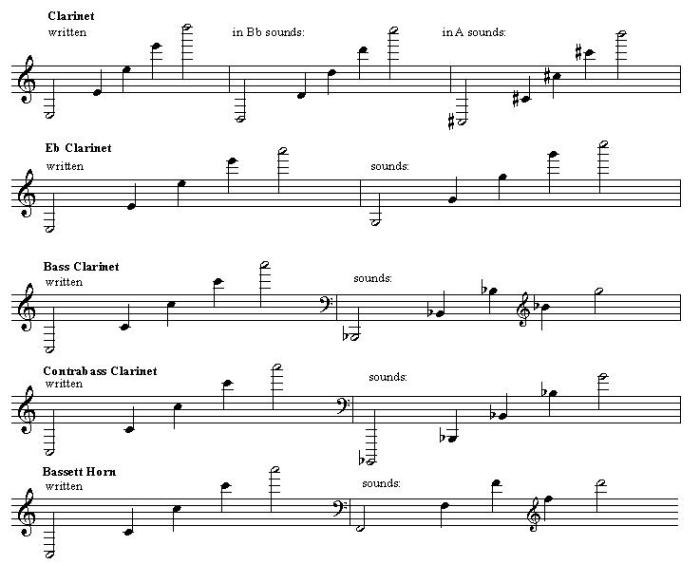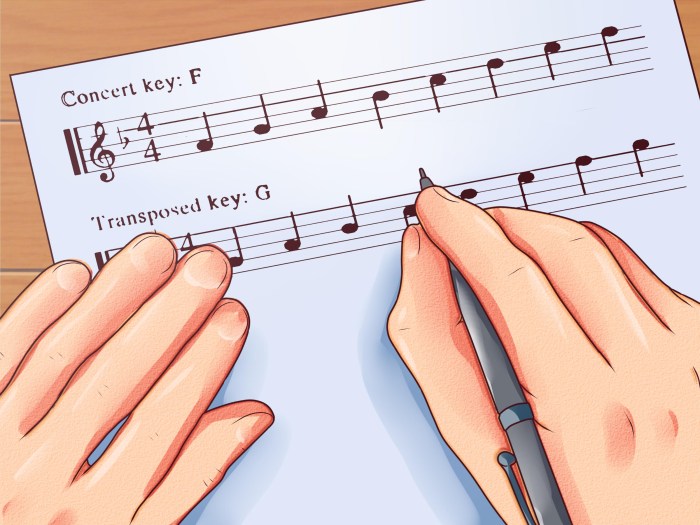Clarinet in b flat transpose – Embark on a musical journey with the clarinet in B-flat transpose, where melodies dance in a unique harmonic realm. This article delves into the captivating world of transposition, exploring the reasons behind the clarinet’s affinity for B-flat and its impact on the instrument’s performance and repertoire.
Transposition, a musical technique that shifts the written pitch of a piece, becomes an integral part of the clarinet’s identity. Discover the advantages and challenges of B-flat transposition, unraveling the intricacies of reading and playing transposed music, and uncover the secrets to mastering this musical art.
Clarinet in B-flat Transposition

The clarinet in B-flat is a transposing instrument, meaning that the written music for the instrument is notated in a different key than the actual sounding pitch. This is done to make it easier for clarinetists to play in different keys without having to learn multiple fingerings for the same notes.
The clarinet in B-flat is typically transposed down a whole tone, so that written C sounds as B-flat when played.
Reasons for Transposition
There are several reasons why the clarinet is typically transposed to B-flat. One reason is that it makes it easier for clarinetists to play in the key of C major, which is the most common key for wind instruments. Another reason is that it allows clarinetists to use the same fingerings for the same notes in different keys, making it easier to learn and play new pieces.
For the clarinet in B flat, transposition is crucial. If you’re looking to delve deeper into music theory, check out the asi se dice level 3 pdf . It offers comprehensive insights into transposition and other musical concepts. Returning to the clarinet in B flat, it’s worth noting that this transposition affects the written music, ensuring that the instrument sounds as intended.
Definition of “Transposition”
Transposition is the act of changing the key of a piece of music without changing the notes themselves. This is done by raising or lowering the pitch of all the notes in the piece by a specific interval. For example, transposing a piece of music up a whole tone would raise the pitch of all the notes by one whole tone.
Definition of “B-flat”
B-flat is a musical note that is one half-step below C. It is notated as Bb and has a frequency of 466.2 Hz.
Advantages of B-flat Transposition

Transposing the clarinet to B-flat offers several significant advantages that enhance its playability and expand its repertoire.
Simplified Fingering Patterns
B-flat transposition simplifies the fingering patterns on the clarinet. In the original key of C, many notes require complex fingerings, including cross-fingerings and awkward hand positions. Transposing to B-flat lowers the pitch by a whole tone, making these fingerings more accessible and reducing the need for complex techniques.
Improved Playability
The simplified fingering patterns resulting from B-flat transposition significantly improve the overall playability of the clarinet. Players can execute passages more easily and accurately, allowing for faster learning and improved technical proficiency. This makes the clarinet more accessible to beginners and allows experienced players to focus on musical expression rather than technical challenges.
Wider Range of Repertoire
B-flat transposition opens up a wider range of repertoire for the clarinet. Many pieces originally written for other instruments, such as the flute or oboe, are transposed to B-flat to make them playable on the clarinet. This allows clarinetists to access a vast library of classical, jazz, and contemporary music that would otherwise be unavailable to them.
Challenges of B-flat Transposition: Clarinet In B Flat Transpose

Reading and playing transposed music for the clarinet in B-flat presents several challenges. Musicians must develop proficiency in transposition to play accurately and confidently in this key. Overcoming these challenges requires understanding the transposition process, practicing regularly, and employing effective strategies.
One significant challenge is the need to mentally adjust fingerings when playing transposed music. The written notes on the page do not correspond directly to the notes produced by the instrument, so clarinetists must transpose the notes in their minds while playing.
This mental process can be demanding, especially for beginners, and requires a strong understanding of musical intervals and key signatures.
Overcoming Challenges
Musicians can overcome the challenges of B-flat transposition by adopting the following strategies:
- Practice regularly:Consistent practice is crucial for developing proficiency in transposition. By playing transposed music regularly, clarinetists can improve their mental agility and strengthen their understanding of musical intervals.
- Use a transposition chart:A transposition chart is a valuable tool that provides a quick reference for transposing notes between different keys. Clarinetists can use this chart to quickly identify the correct fingerings for transposed notes.
- Listen to recordings:Listening to recordings of transposed music can help clarinetists develop a better understanding of how the music should sound. By listening to experienced musicians play transposed pieces, they can learn from their phrasing, articulation, and overall interpretation.
Other Instruments in B-flat Transposition

Beyond the clarinet, several other instruments are commonly transposed to B-flat. These include:
- Trumpet
- Tenor saxophone
- Baritone saxophone
- Euphonium
- Tuba
Like the clarinet, these instruments are all pitched in B-flat, meaning they sound a whole tone lower than written. This transposition allows these instruments to play in a more comfortable range, particularly in the higher registers.
Comparison with Clarinet Transposition
While all these instruments use B-flat transposition, there are some key differences in their transposition practices compared to the clarinet:
- Range:The clarinet has a wider range than most other B-flat transposed instruments, extending from the low E♭ to the high C. This allows it to play both high and low notes with ease.
- Fingerings:The fingerings for B-flat transposed instruments are generally similar to those of the clarinet, but there are some minor differences. For example, the fingering for middle C on the clarinet is different from the fingering for middle C on the trumpet.
- Key signature:When playing in a key with sharps, B-flat transposed instruments typically use one less sharp in their key signature than the clarinet. For example, in the key of G major, the clarinet would use three sharps (#) in its key signature, while the trumpet would use only two (#).
Historical and Musical Reasons
The use of B-flat transposition for these instruments has historical and musical roots. In the early days of music, instruments were not standardized, and each instrument had its own unique pitch. Over time, certain pitches became more common, and the use of B-flat transposition became widespread for instruments that played in the middle range.
B-flat transposition also allows these instruments to blend more easily with other instruments in an ensemble. For example, the trumpet and clarinet are often used together in jazz bands, and the B-flat transposition helps them to create a more harmonious sound.
Impact on Performance

B-flat transposition has a significant impact on the sound and performance of the clarinet. It alters the pitch and tonal characteristics of the instrument, affecting its expressiveness and versatility.
Tonal Characteristics, Clarinet in b flat transpose
The B-flat transposition lowers the pitch of the clarinet by a whole tone compared to its written notation. This gives it a warmer, mellower sound compared to clarinets in other transpositions, such as A or C. The lower pitch also allows for greater resonance and projection, making it suitable for both solo and ensemble playing.
Expressiveness
The B-flat transposition enhances the expressiveness of the clarinet. The lower pitch allows for a wider range of dynamics, from soft and delicate to loud and powerful. The mellower sound also lends itself to expressive playing, allowing clarinetists to convey emotions and nuances with greater ease.
Versatility
B-flat transposition increases the versatility of the clarinet. The lower pitch makes it more suitable for playing in lower registers, allowing for greater flexibility in repertoire. Additionally, the B-flat transposition is commonly used in band and orchestral settings, making it an essential instrument for musicians who want to perform in these ensembles.
FAQ
Why is the clarinet typically transposed to B-flat?
Transposing the clarinet to B-flat simplifies fingering patterns, making it easier to play in various keys.
What are the challenges of playing transposed music on the clarinet?
Reading and interpreting transposed music requires practice and attention to detail, as the written notes differ from the actual sounding pitches.
How can clarinetists overcome the challenges of transposition?
Regular practice, sight-reading exercises, and understanding the principles of transposition can help clarinetists develop proficiency in playing transposed music.